Fujifilm Fujinon XF 50-140 mm f/2.8 R LM OIS WR
3. Build quality and image stabilization
In the photo below the tested lens is positioned next to the Fujinon XF 18–55 mm f/2.8–4.0.
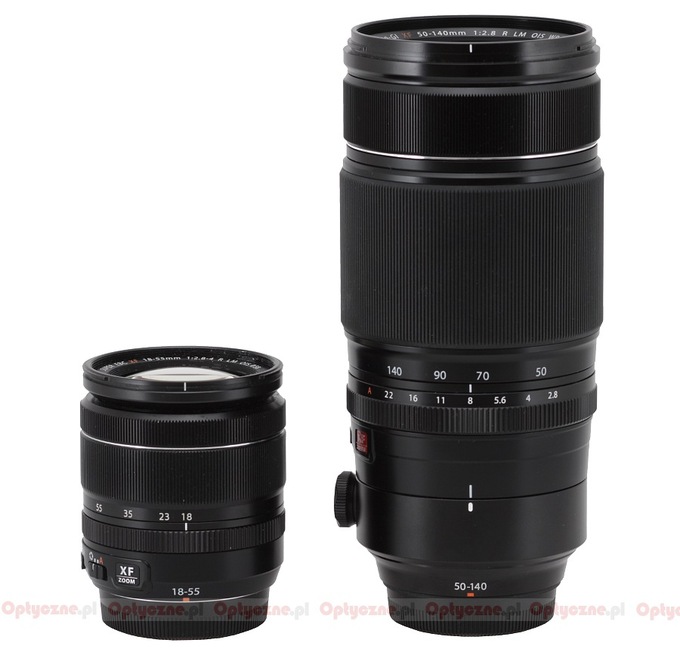 |
Please Support UsIf you enjoy our reviews and articles, and you want us to continue our work please, support our website by donating through PayPal. The funds are going to be used for paying our editorial team, renting servers, and equipping our testing studio; only that way we will be able to continue providing you interesting content for free. |
- - - - - - - - - - - - - - - - - - - - - - - - - - - - - - - - - - - - - - - - - - - - - - - -
The Fujinon XF 50–140 mm f/2.8 R LM OIS WR begins with a metal mount surrounding contacts and a rear element, about 2 cm in diameter. That element doesn’t move and it is hidden about 1.5 cm deep inside a properly darkened and matted tube.
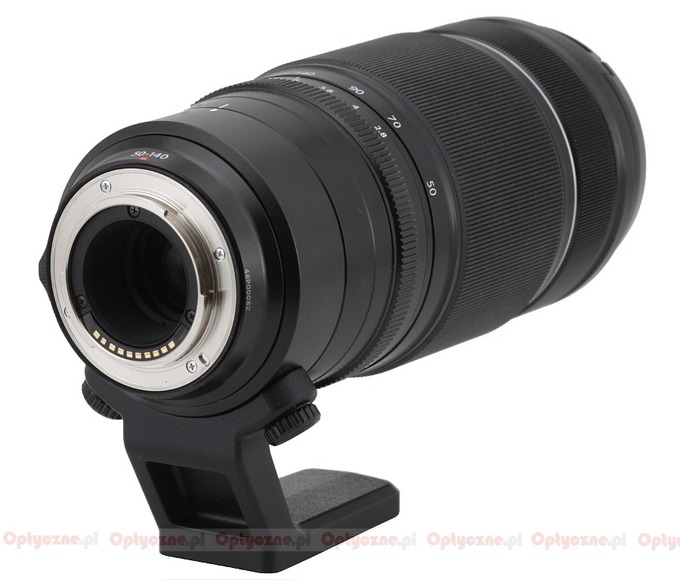 |
The first part of the proper body of the lens is a metal, immobile ring widening after a while, on which you can find a red dot, making the alignment with a camera easier, the focal range of the lens, its serial number and information that it was produced in Japan.
Further on you see a rotating ring joined with a stable tripod stand adapter. The solution is really original: the adapter cannot be removed from the lens with the ring but it is possible to separate those two by unscrewing the adapter with the help of special, comfortable screws.
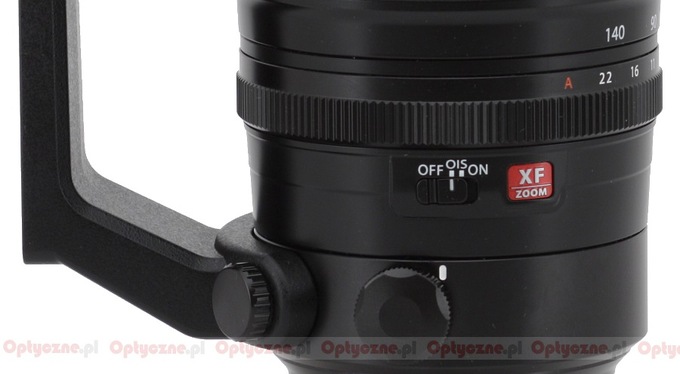 |
The next part is another ring which doesn’t move with such inscriptions as „XF ZOOM” and „WEATHER RESISTANT”, featuring also an optical stabilization switch (OIS ON/OFF). Immediately afterwards you see an aperture ring. It is 15 mm wide and most of its surface is covered by ribbing. The aperture can be changed every 1/3 EV step and the ring is a joy to use.
The biggest part of the casing is a zoom ring, as wide as 65 mm, its majority covered by rubber ribs; under it you can find focal lengths markings at 50, 70, 90 and 140 mm. The ring moves well – it is smooth, even and is well-damped.
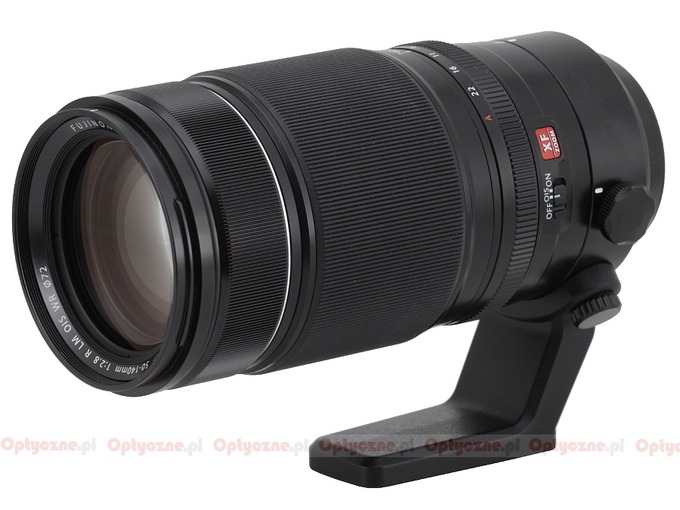 |
The next part is a manual focus ring. It is 22 mm wide, completely covered by rubber ribbing but without any scale. The ring works with electronic relay and is really beyond reproach. Running through the whole scale takes a turn through as much as 360 degrees. When it comes to manual settings it really ensures a great degree of precision.
The front element of the Fujinon 50–140 is 55 mm in diameter and it doesn’t move. It is surrounded by an inscription with the name and the parameters of the lens, a non-rotating filter thread, 72 mm in diameter and a hood thread.
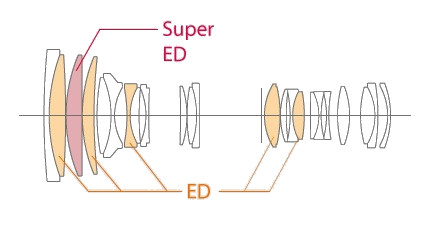 |
When it comes to the inner construction of the lens you deal here with 23 elements positioned in 16 groups. Five of them were made of low dispersion ED glass and another one – of Super ED glass. Inside you also find a round aperture with seven diaphragm blades which can be closed down to a value of f/22.
Buyers get both caps, a petal-type hood, a tripod stand adapter and a soft pouch in the box.
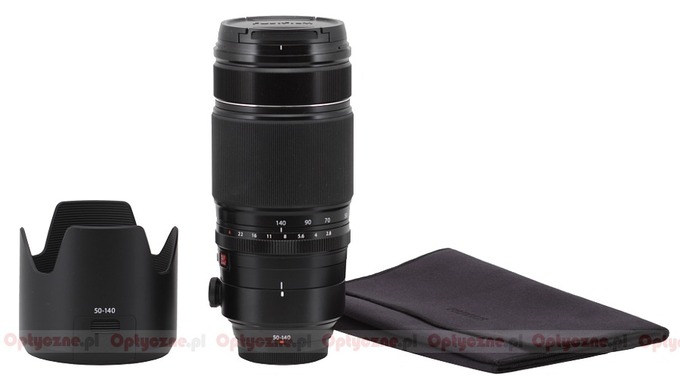 |
Image stabilization
Usually different producers boast of stabilization efficiency as high as 4 EV. However our measurements prove that it is true for few optical instruments . Still there are always exceptions to the rule and among them you can find the newest 70-200 mm class lenses. For instance the Canon EF 70–200 mm f/2.8L IS II USM and the Nikkor AF-S 70–200 mm f/4.0G ED VR managed to reach a splendid result of 4.3 EV.
Of course we decided to check how the Fujinon fares in this category. In order to do so we took several dozen photos at 140 mm focal length for every exposure time ranging from 1/160 to 1/2 of a second with the stabilization switched on and off. Then we determined a percentage of blurred photos and presented it as an exposure time function graph, expressed in EV (with the 0 EV point being the equivalent of 1/125 of a second).
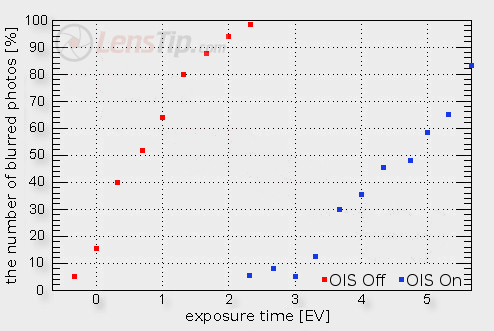
As you can notice the Fujinon XF 50–140 mm f/2.8 R LM OIS WR fares very well here, reaching a result of 4.3 EV, exactly the same as its renowned, full frame rivals. It’s also a value by about 0.5 EV better than the result of the Panasonic G X VARIO 35–100 mm f/2.8 P.O.I.S.






